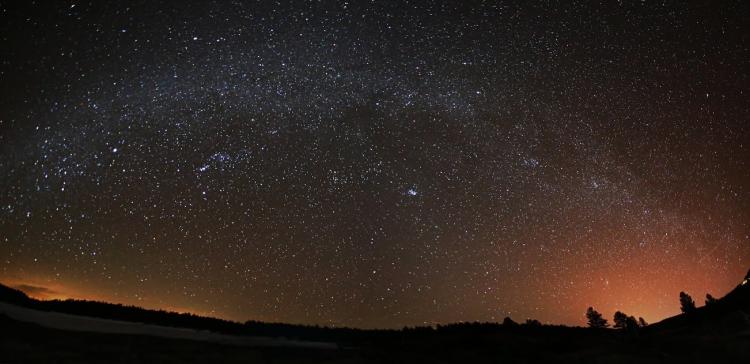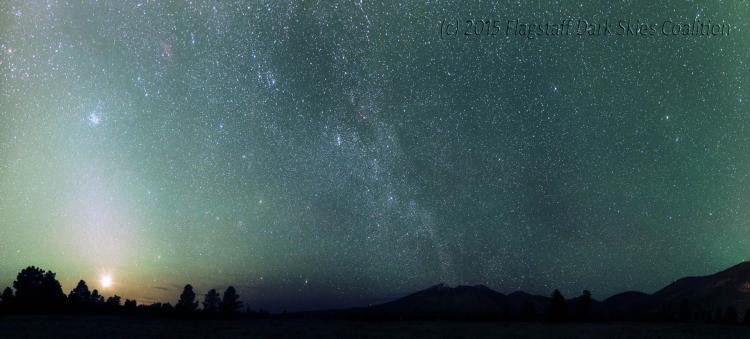Dark Skies, Not Just for Astronomers
By Bonnie Stevens

When Flagstaff artist S.D. Nelson was growing up, his mother, a member of the Lakota Tribe, told him wondrous stories about the Earth and sky. “I remember one night, she pointed into the night sky and said if I looked carefully, I would see my great, great grandfather, Flying Cloud, riding his horse along the white road of the Milky Way.”
For a 10-year-old boy, that was a wonderful story. But for most of us at any age, a star-filled sky sparks imagination, inspiration and a connection to the universe.
In Flagstaff, we can count on the cloudy streak of the Milky Way to slice diagonally through clear nights just as we can expect to see the moon, planets, stars, nebulae and constellations. But this is not a view that everyone has.
Drew Carhart, a member of the Flagstaff Dark Skies Coalition, has a home in the Chicago area. He visits Flagstaff often to get lost in the starry nights. “It has been my experience that if you live in an area where you can still see the stars, you do kind of take that for granted. Most people in urban settings never see the universe the way Flagstaff sees it. Probably 80% of the population around my home have never seen the Milky Way or gazed in amazement at the sight of a thousand stars in the night sky.”
The International Dark-Sky Association (IDA) website, https://www.darksky.org, states that Vincent Van Gogh painted his famous “Starry Night” in Saint Rémy, France, in 1889. “Now, the Milky Way can no longer be seen from there.” It goes on to pose the question, “If he were alive today, would he still be inspired to paint ‘Starry Night?’”
Certainly something to ponder, and there are other things to consider when assessing the value of a starry night.

Human Health
The ‘80s band, DeBarge celebrated the “Rhythm of the Night,” but scientists and health professionals might suggest we all start singing the praises of the rhythm of the day and night – the Circadian Rhythm – that humans have evolved with. Clinical *studies show that artificial light at night can negatively impact our health, as more evidence connects the loss of darkness with obesity, depression, insomnia, even cancer. (*International Agency for Research on Cancer – World Health Organization, 2007)
Wildlife Health
As night skies brighten around the globe, animal behavior is being disrupted in places where night now feels like day because of light pollution. Scientists are concerned that nocturnal animals cued by darkness to hunt, hide, travel or mate are getting confused. Migrating birds that use the moon and stars to navigate now can get pulled off course; baby sea turtles have been found to go toward artificial light on shore to their demise, rather than the glimmering ocean reflecting the moon and stars.
Energy Conservation
The IDA estimates that at least 30% of all outdoor lighting in the U.S. is wasted from light that isn’t shielded. It states, “That adds up to $3.3 billion and the release of 21 million tons of carbon dioxide per year!” Lighting is important for illuminating our paths at night and revealing street addresses for public safety so emergency personnel can find locations, but glaring light helps no one. And wouldn’t we all be happy to save some money on our electric bills?
Economic Benefits
Tourism officials says there’s been a growing interest in dark-sky experiences. In fact, state and national parks that have earned dark-sky status from the IDA are seeing measurable increases in the numbers of guests. Northern Arizona enjoys some of the darkest skies in the world and communities around destinations like Grand Canyon, Wupatki, Sunset Crater Volcano and Walnut Canyon benefit from tourism dollars as travelers seek out their dark-sky adventures. Flagstaff was recognized by the IDA in 2001 as the First International Dark-Sky City, anchoring the entire IDA Dark-Sky places program, which now recognizes more than 180 communities, parks and reserves worldwide,
Astronomical Discovery
For astronomers, the night sky is critical and for Flagstaff, it always has been a valued community asset. Lowell Observatory was part of the skyscape before Flagstaff became a town and astronomers here have made important discoveries, like Pluto. Since then, the collective investment from Lowell, the U.S. Naval Observatory and Northern Arizona University has soared well above $125 million.
The scientific and educational benefits of Northern Arizona’s dark skies are likely enough to convince us all to do what we can to protect dark skies, but as retired USNO astronomer Chris Luginbuhl has said, “Preserving the night sky just for astronomers would be like preserving Grand Canyon just for geologists. The night sky and the Grand Canyon matter to all of us, everywhere.”

